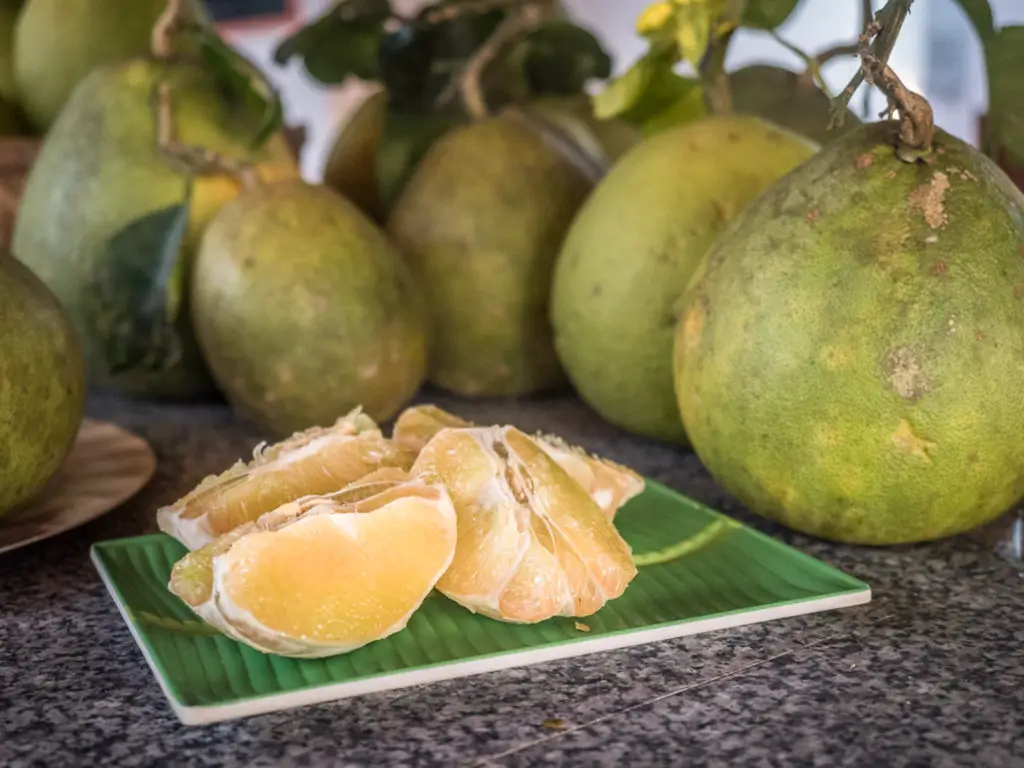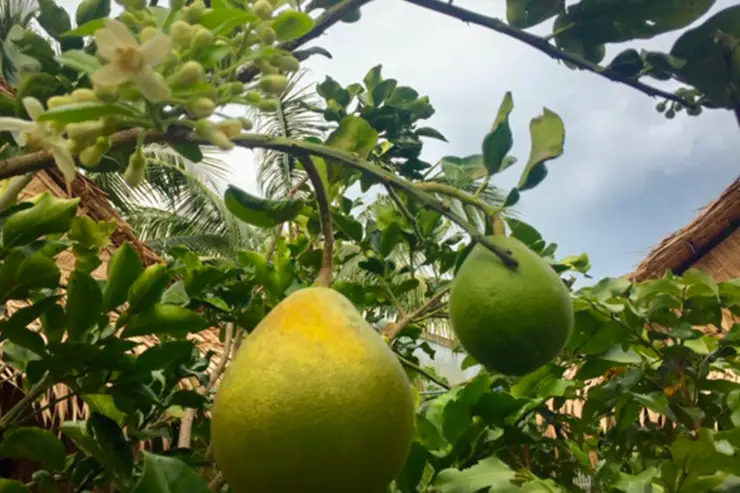As an Amazon Associate I earn from qualifying purchases. Please read the disclaimer for more info.
Pomelo fruit is a tropical citrus fruit that has recently gained popularity. It is a large fruit that can weigh up to several pounds and has a thick, greenish-yellow rind. The fruit is native to Southeast Asia and is commonly found in countries like Vietnam, Thailand, Malaysia, and Indonesia.
Pomelo fruit is often compared to grapefruit due to its similar appearance and taste. However, pomelo fruit is less bitter and has a sweeter taste. It is also a good source of vitamin C and other nutrients, making it a healthy addition to one’s diet.
Despite its growing popularity, many people are still unfamiliar with pomelo fruit. This article will provide an in-depth look at what pomelo fruit is, its nutritional benefits, and how to enjoy it in various ways.
What Is Pomelo Fruit?

Pomelo fruit is a large citrus fruit that is native to Southeast Asia. It is also known as Chinese grapefruit, shaddock, or pummelo. The fruit is closely related to grapefruit and is the largest of all citrus fruits. It can range in size from a small grapefruit to a large watermelon.
The fruit’s scientific name is citrus maxima.
The pomelo fruit has a thick, spongy rind that is usually pale green or yellow in color. The flesh inside is juicy and sweet, with a slightly tart taste. It is often eaten fresh or used in salads, jams, and other dishes.
One of the unique features of pomelo fruit is its high vitamin C content. It is also a good source of potassium, fiber, and other nutrients. Some studies have even suggested that pomelo fruit may have health benefits such as reducing inflammation and promoting heart health.
Overall, pomelo fruit is a delicious and nutritious addition to any diet. Its refreshing taste and health benefits make it popular among citrus lovers.
Origin and History

Geographical Origins
Pomelo fruit is believed to have originated in Southeast Asia, specifically in Malaysia and Indonesia. It is also commonly grown in other countries in the region, such as Thailand, Vietnam, and the Philippines. The fruit is now widely cultivated in other parts of the world, including the United States, China, and Israel.
Historical Significance
Pomelo fruit has a long history of cultivation and consumption in Southeast Asia, where it is highly valued for its sweet and tangy flavor as well as its medicinal properties. In ancient times, the fruit was used as a natural remedy for a variety of ailments, including coughs, fever, and digestive issues.
Over the centuries, pomelo fruit has become an important part of the cultural and culinary traditions of many Southeast Asian countries. In Thailand, for example, the fruit is often used in traditional dishes such as som tam (green papaya salad) and yam som-o (pomelo salad). In Vietnam, pomelo fruit is used in a popular dessert called che buoi, which consists of sweetened pomelo pulp mixed with coconut milk and other ingredients.
Today, pomelo fruit is enjoyed by people all over the world for its unique flavor and health benefits. It is rich in vitamins and minerals and is believed to have antioxidant and anti-inflammatory properties that can help protect against a variety of diseases and conditions.
Nutritional Profile
Pomelo fruit is a nutrient-dense fruit that is packed with vitamins, minerals, and dietary fiber. Here is a breakdown of its nutritional profile:
Vitamins and Minerals
Pomelo is an excellent vitamin C source, a powerful antioxidant that helps protect the body against free radicals. In fact, one cup of pomelo provides more than 100% of the recommended daily intake of vitamin C. Pomelo is also rich in potassium, which is important for maintaining healthy blood pressure levels. Other vitamins and minerals in pomelo include vitamin A, B6, thiamin, folate, and magnesium.
Dietary Fiber Content
Pomelo is a good source of dietary fiber, which is important for maintaining healthy digestion and preventing constipation. One cup of pomelo contains about 3 grams of fiber, which is about 12% of the recommended daily intake.
Caloric Value
Pomelo is a low-calorie fruit, making it a great choice for those who are watching their weight. One cup of pomelo contains only about 70 calories, which is much lower than other fruits like bananas and grapes.
In conclusion, pomelo is a nutritious fruit that is packed with vitamins, minerals, and dietary fiber. It is a great addition to any healthy diet and can provide a variety of health benefits.
Health Benefits
Pomelo fruit is not only delicious but also packed with health benefits. Here are some of the ways in which pomelo can benefit your health:
Digestive Health
Pomelo is a great source of dietary fiber, which can help promote healthy digestion. Fiber helps to regulate bowel movements and prevent constipation. In addition, pomelo contains enzymes that can aid in the breakdown of proteins and fats, making it easier for the body to digest food.
Immune System Support
Pomelo is rich in vitamin C, which is essential for a healthy immune system. Vitamin C helps to boost the production of white blood cells, which are responsible for fighting off infections and diseases. In addition, pomelo contains antioxidants that can help to protect the body against free radical damage.
Heart Health
Pomelo is low in calories and contains no cholesterol, making it a heart-healthy food choice. In addition, pomelo contains potassium, which can help to regulate blood pressure and reduce the risk of heart disease. Pomelo also contains flavonoids, which have been shown to reduce inflammation and improve blood flow.
Overall, pomelo is a nutritious fruit that can provide a range of health benefits. Whether you are looking to improve your digestive health, support your immune system, or promote heart health, adding pomelo to your diet can be a great way to achieve your health goals.
Varieties of Pomelo
Types and Characteristics
Pomelo is a citrus fruit that comes in different varieties. The most common types of pomelo are:
- Chandler Pomelo: This variety has yellow-green skin and is known for its sweet and juicy pulp. It is a large fruit that can weigh up to 2 kilograms.
- Honey Pomelo: This variety has thin skin and a yellowish-green color. It is known for its sweet and fragrant taste.
- Pink Pomelo: This variety has pinkish-red flesh and thin skin. It is sweeter than other types of pomelo and has a slightly acidic taste.
- Reinking Pomelo: This variety has a yellow-green skin and a sweet and juicy pulp. It is smaller than other types of pomelo and has a slightly tart taste.
Flavor Differences
Each variety of pomelo has its own unique flavor and characteristics. Chandler pomelo is known for its sweetness and juiciness, while honey pomelo has a fragrant and sweet taste. Pink pomelo is sweeter than other varieties and has a slightly acidic taste. Reinking pomelo has a slightly tart taste and is smaller than other varieties.
In terms of nutritional value, all types of pomelo are high in vitamin C, fiber, and antioxidants. They are also low in calories and fat, making them a healthy snack option.
Overall, pomelo is a delicious and nutritious fruit that comes in different varieties, each with its own unique flavor and characteristics.
Cultivation
Growing Conditions
Pomelo trees require warm and humid climates to grow. They prefer well-drained soil that is rich in organic matter. The ideal temperature for pomelo cultivation is between 25°C to 35°C. The trees require full sunlight exposure for optimum growth.
Pomelo trees can be propagated through seeds or by grafting. Seedlings should be planted in well-prepared soil, and it takes about four to six years for them to mature and bear fruit. Grafted trees, on the other hand, produce fruit in about three years.
Harvesting Practices
Pomelo fruit is harvested when it reaches full maturity. The fruit is usually picked by hand, and care should be taken not to damage the fruit or the tree during the process.
Pomelo fruit can be stored in a cool, dry place for up to two weeks before it starts to spoil. It is important to handle the fruit carefully during storage to prevent any damage that could lead to spoilage.
In some regions, pomelo fruit is harvested twice a year. The first harvest is usually in the winter, while the second harvest is in the summer. The fruit harvested in the winter is usually larger and sweeter than the fruit harvested in the summer.
Pomelo cultivation requires careful attention to growing conditions and harvesting practices to ensure a healthy and productive crop.
Buying and Storage Tips
Selection Criteria
When selecting pomelos, look for ones that are heavy for their size and have firm, unblemished skin. The skin should be thick and have a slight give when pressed. Avoid any fruits that have soft spots, bruises, or signs of mold.
It is also important to choose pomelos that are ripe but not overripe. Overripe pomelos will have a mushy texture and a sour taste. To check for ripeness, give the fruit a gentle squeeze. If it feels slightly soft, it is ready to eat.
Storage Methods
Pomelos can be stored at room temperature for a few days but will last longer if kept in the refrigerator. To store a whole pomelo, wrap it in plastic wrap and place it in the refrigerator’s crisper drawer. It should last for up to two weeks.
If you have already cut the pomelo, store the remaining pieces in an airtight container in the refrigerator. They will last for up to three days. Avoid storing cut pomelo at room temperature, as it will quickly spoil.
When storing pomelos, keep them away from other fruits and vegetables that produce ethylene gas, such as apples and bananas. Ethylene gas can cause the pomelo to ripen too quickly and spoil.
Fun Facts and Trivia
Pomelo fruit is not only delicious but also has some interesting facts and trivia associated with it. Here are a few fun facts about pomelo fruit that you may not have known:
- Pomelo is the largest citrus fruit in the world, with some varieties weighing up to 2 kilograms.
- Pomelo is native to Southeast Asia but is now grown in many parts of the world, including Australia, the Caribbean, and the United States.
- Pomelo is rich in vitamin C and other antioxidants essential for maintaining good health.
- In some cultures, pomelo is considered a symbol of good luck and prosperity, and it is often given as a gift during the Chinese New Year.
- Pomelo is often used in traditional medicine to treat a variety of ailments, including coughs, fever, and high blood pressure.
- The peel of the pomelo fruit is often candied and used as a snack or dessert ingredient.
- Pomelo is a low-calorie fruit, making it an excellent choice for those watching their weight.
- Pomelo is sometimes called the “forbidden fruit” because it was once reserved for the emperor in ancient China.
Overall, pomelo fruit is tasty and has a rich history and interesting cultural significance.

